
Hoverflies, also called flower flies or syrphids, make up the insect family Syrphidae. As their common name suggests, they are often seen hovering or nectaring at flowers; the adults of many species feed mainly on nectar and pollen, while the larvae (maggots) eat a wide range of foods. In some species, the larvae are saprotrophs, eating decaying plant and animal matter in the soil or in ponds and streams. In other species, the larvae are insectivores and prey on aphids, thrips, and other plant-sucking insects.
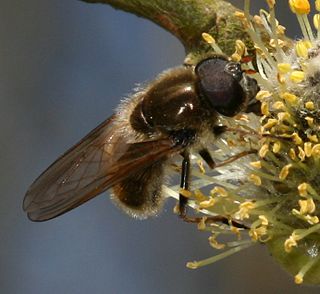
Cheilosia albipila is a European and Palearctic species of hoverfly. Like most Cheilosia it is black, and because of this may often be overlooked as a hoverfly. It is little recorded but probably widespread and common and maybe overlooked because adult flight periods are early in the year, before many hoverfly recorders are active.

Cheilosia is a genus of hoverfly. Most Cheilosia are black or largely un-coloured, lacking the bright colours and patterns of many hoverfly species. It is one of the most species diverse genera of hoverflies. The biology of many species is little understood, but where known, the larvae of Cheilosia species feed in the stems of plants or in fungi.

Cheilosia carbonaria is a European species of hoverfly. Like most Cheilosia it is black, and because of this may often be overlooked as a hoverfly. It is little recorded, and is considered rare and scarce throughout most of its range.
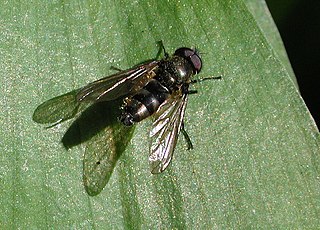
Cheilosia fasciata is a European species of hoverfly. Like most Cheilosia it is mostly black,
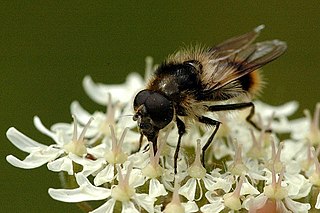
Cheilosia illustrata is a species of hoverfly belonging to the family Syrphidae.
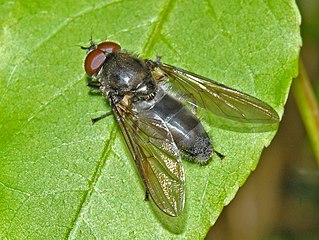
Cheilosia variabilis, common name figwort cheilosia, is a species of hoverfly belonging to the family Syrphidae.

Cheilosia mutabilis is a European species of hoverfly. Like most Cheilosia it is black, and because of this may often be overlooked as a hoverfly. It is little recorded, and is considered rare and scarce throughout most of its range.
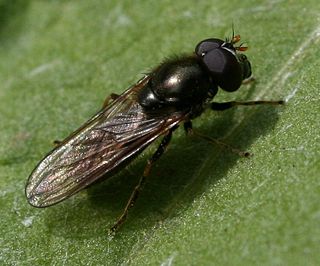
Cheilosia pagana is a Holarctic species of hoverfly. Like most Cheilosia it is black, and because of this may often be overlooked as a hoverfly. One identifying feature is a large red to orange 3rd antennal segment.

The Brachyopini is a tribe of hoverflies. Unlike many members of this family these flies are generally darker and less colourful though some genera contain species with an attractive metallic lustre e.g. Chrysogaster. Some like Brachyopa are associated with sap runs where their larvae feed on decaying sap. Others are found in boggy areas where their often semiaquatic larvae feed on decaying organic matter.

Cheilosia grossa is a widespread European species of hoverfly. Adults can be found in spring on sallow catkins and the larvae tunnel in the stems of various thistle species.

Cheilosia albitarsis is an abundant European species of hoverfly. Adults can be found in spring visiting buttercup flowers and this plant is also the larval hostplant.

Cheilosia proxima is a European species of hoverfly.
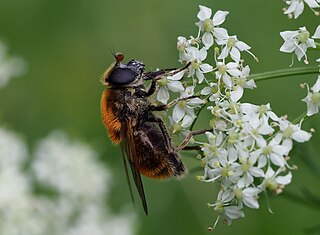
Cheilosia chrysocoma is a European species of hoverfly.

Cheilosia psilophthalma is a Palearctic hoverfly closely related and very similar to Cheilosia latigenis, Cheilosia mutabilis and Cheilosia urbana . It is a rare and little known species recorded from Scandinavia, Ireland, Britain, France, Poland, Switzerland, Greece, Montenegro, Serbia, Ukraine and European Russia. Flowers visited include Acer platanoides, Anemone nemorosa, Primula veris, Prunus spinosa and Salix spp. Cheilosia psilophthalma flies in April and May. Open, grassy areas within sparse woodland and unimproved, montane subalpine grassland are preferred habitats. Larvae are recorded as developing in Hieracium pilosella and Hieracium caespitosum.
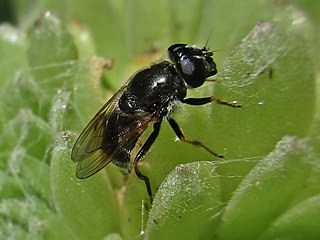
Cheilosia caerulescens is a Palearctic hoverfly.
Cheilosia lasiopa is a Palearctic hoverfly. This species was previously misidentified as Cheilosia honesta.
Cheilosia nigripes is a Palearctic hoverfly.

The Brachyopina is a subtribe of hoverflies.















